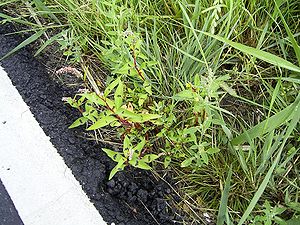Note: This is a project under development. The articles on this wiki are just being initiated and broadly incomplete. You can Help creating new pages.
Persicaria maculosa - Spotted lady thumb
Persicaria maculosa is an annual plant in the buckwheat family Polygonaceae. It is widespread across Eurasia from Iceland south to Portugal and east to Japan. It is also present as an introduced and invasive species in North America, where it was first noted in the Great Lakes region in 1843 and has now spread through most of the continent.
Contents
- 1 Uses
- 2 Parts Used
- 3 Chemical Composition
- 4 Common names
- 5 Properties
- 6 Habit
- 7 Identification
- 8 List of Ayurvedic medicine in which the herb is used
- 9 Where to get the saplings
- 10 Mode of Propagation
- 11 How to plant/cultivate
- 12 Commonly seen growing in areas
- 13 Photo Gallery
- 14 References
- 15 External Links
Uses
Stomach pains, Gravel pains, Rheumatism, Poison ivy rash, Colds, Coughs, Pimples, Diarrhea, Sore throats
Parts Used
Chemical Composition
It contains Phenolics, peptides, terpenoids, and sterols etc.[1]
Common names
| Language | Common name |
|---|---|
| Kannada | |
| Hindi | |
| Malayalam | |
| Tamil | |
| Telugu | |
| Marathi | NA |
| Gujarathi | NA |
| Punjabi | NA |
| Kashmiri | NA |
| Sanskrit | |
| English | Redshank, Lady's-thumb |
Properties
Reference: Dravya - Substance, Rasa - Taste, Guna - Qualities, Veerya - Potency, Vipaka - Post-digesion effect, Karma - Pharmacological activity, Prabhava - Therepeutics.
Dravya
Rasa
Tikta (Bitter), Kashaya (Astringent)
Guna
Laghu (Light), Ruksha (Dry), Tikshna (Sharp)
Veerya
Ushna (Hot)
Vipaka
Katu (Pungent)
Karma
Kapha, Vata
Prabhava
Habit
Identification
Leaf
| Kind | Shape | Feature |
|---|---|---|
| Simple | Alternate | Narrowly lance-shaped, about 6x longer than wide, with pointed tips |
Flower
| Type | Size | Color and composition | Stamen | More information |
|---|---|---|---|---|
| Unisexual | 1/8 inch long | Rose-pink | 4 to 8 | The flowers are 5-parted, with a perianth that may be greenish-white at the base to rose at the tip |
Fruit
| Type | Size | Mass | Appearance | Seeds | More information |
|---|---|---|---|---|---|
| General | 7–10 mm | Each flower is replaced by a seed that is ovoid | Slightly 3-angled, black, and shiny | Many | {{{6}}} |
Other features
List of Ayurvedic medicine in which the herb is used
Where to get the saplings
Mode of Propagation
How to plant/cultivate
Commonly seen growing in areas
Damp shady places, Cultivated land, Borders of forests.
Photo Gallery
References
- ↑ Chemical constituents
- ↑ Plant decsription
- ↑ [Cultivation details]
External Links
- Ayurvedic Herbs known to be helpful to treat Stomach pains
- Ayurvedic Herbs known to be helpful to treat Gravel pains
- Ayurvedic Herbs known to be helpful to treat Rheumatism
- Ayurvedic Herbs known to be helpful to treat Poison ivy rash
- Ayurvedic Herbs known to be helpful to treat Colds
- Ayurvedic Herbs known to be helpful to treat Coughs
- Ayurvedic Herbs known to be helpful to treat Pimples
- Ayurvedic Herbs known to be helpful to treat Diarrhea
- Ayurvedic Herbs known to be helpful to treat Sore throats
- Herbs with Leaves used in medicine
- Herbs with Seeds used in medicine
- Herbs with common name in English
- Habit - Shrub
- Index of Plants which can be propagated by Seeds
- Herbs that are commonly seen in the region of Damp shady places
- Herbs that are commonly seen in the region of Cultivated land
- Herbs that are commonly seen in the region of Borders of forests
- Herbs
- Ayurvedic herbs that don't have seed photos
- Polygonaceae







